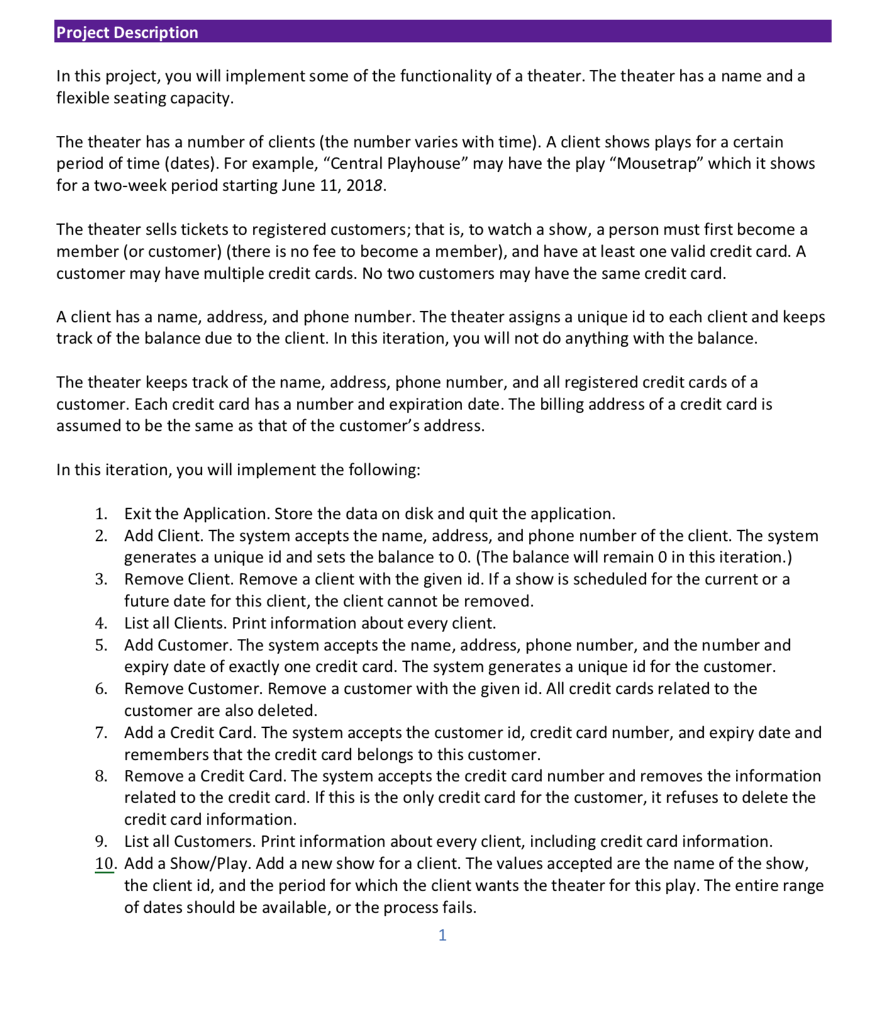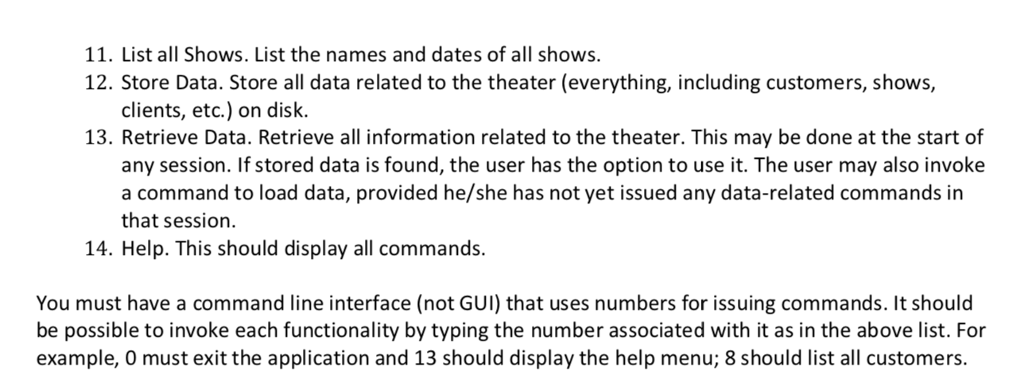Answered step by step
Verified Expert Solution
Question
1 Approved Answer
Java code for every class, including the user interface. Project Description In this project, you will implement some of the functionality of a theater. The
Java code for every class, including the user interface.

Project Description In this project, you will implement some of the functionality of a theater. The theater has a name and a flexible seating capacity The theater has a number of clients (the number varies with time). A client shows plays for a certain period of time (dates). For example, "Central Playhouse" may have the play Mousetrap" which it shows for a two-week period starting June 11, 2018 The theater sells tickets to registered customers; that is, to watch a show, a person must first become a member (or customer) (there is no fee to become a member), and have at least one valid credit card. A customer may have multiple credit cards. No two customers may have the same credit card A client has a name, address, and phone number. The theater assigns a unique id to each client and keeps track of the balance due to the client. In this iteration, you will not do anything with the balance The theater keeps track of the name, address, phone number, and all registered credit cards of a customer. Each credit card has a number and expiration date. The billing address of a credit card is assumed to be the same as that of the customer's address In this iteration, you will implement the following Exit the Application. Store the data on disk and quit the application Add Client. The system accepts the name, address, and phone number of the client. The system generates a unique id and sets the balance to 0. (The balance will remain 0 in this iteration.) Remove Client. Remove a client with the given id. If a show is scheduled for the current or a future date for this client, the client cannot be removed List all Clients. Print information about every client Add Customer. The system accepts the name, address, phone number, and the number and expiry date of exactly one credit card. The system generates a unique id for the customer Remove Customer. Remove a customer with the given id. All credit cards related to the customer are also deleted Add a Credit Card. The system accepts the customer id, credit card number, and expiry date and remembers that the credit card belongs to this customer Remove a Credit Card. The system accepts the credit card number and removes the information related to the credit card. If this is the only credit card for the customer, it refuses to delete the credit card information. 1. 2. 3. 4. 5. 6. 7. 8. 9. List all Customers. Print information about every client, including credit card information 10. Add a Show/Play. Add a new show for a client. The values accepted are the name of the show, the client id, and the period for which the client wants the theater for this play. The entire range of dates should be available, or the process fails Project Description In this project, you will implement some of the functionality of a theater. The theater has a name and a flexible seating capacity The theater has a number of clients (the number varies with time). A client shows plays for a certain period of time (dates). For example, "Central Playhouse" may have the play Mousetrap" which it shows for a two-week period starting June 11, 2018 The theater sells tickets to registered customers; that is, to watch a show, a person must first become a member (or customer) (there is no fee to become a member), and have at least one valid credit card. A customer may have multiple credit cards. No two customers may have the same credit card A client has a name, address, and phone number. The theater assigns a unique id to each client and keeps track of the balance due to the client. In this iteration, you will not do anything with the balance The theater keeps track of the name, address, phone number, and all registered credit cards of a customer. Each credit card has a number and expiration date. The billing address of a credit card is assumed to be the same as that of the customer's address In this iteration, you will implement the following Exit the Application. Store the data on disk and quit the application Add Client. The system accepts the name, address, and phone number of the client. The system generates a unique id and sets the balance to 0. (The balance will remain 0 in this iteration.) Remove Client. Remove a client with the given id. If a show is scheduled for the current or a future date for this client, the client cannot be removed List all Clients. Print information about every client Add Customer. The system accepts the name, address, phone number, and the number and expiry date of exactly one credit card. The system generates a unique id for the customer Remove Customer. Remove a customer with the given id. All credit cards related to the customer are also deleted Add a Credit Card. The system accepts the customer id, credit card number, and expiry date and remembers that the credit card belongs to this customer Remove a Credit Card. The system accepts the credit card number and removes the information related to the credit card. If this is the only credit card for the customer, it refuses to delete the credit card information. 1. 2. 3. 4. 5. 6. 7. 8. 9. List all Customers. Print information about every client, including credit card information 10. Add a Show/Play. Add a new show for a client. The values accepted are the name of the show, the client id, and the period for which the client wants the theater for this play. The entire range of dates should be available, or the process fails
Step by Step Solution
There are 3 Steps involved in it
Step: 1

Get Instant Access to Expert-Tailored Solutions
See step-by-step solutions with expert insights and AI powered tools for academic success
Step: 2

Step: 3

Ace Your Homework with AI
Get the answers you need in no time with our AI-driven, step-by-step assistance
Get Started


